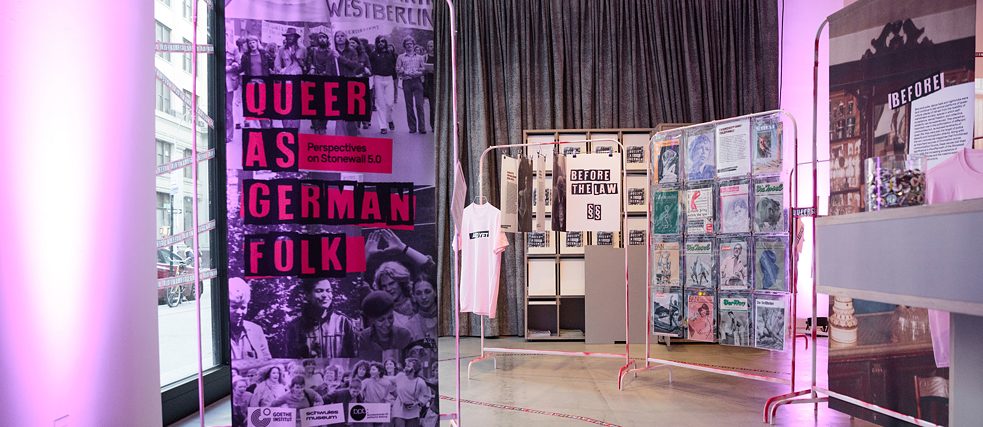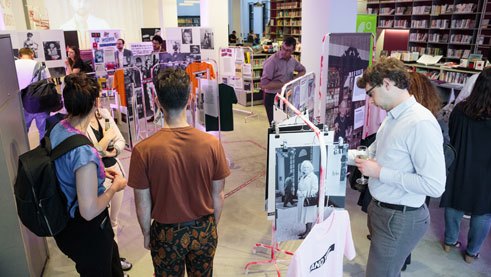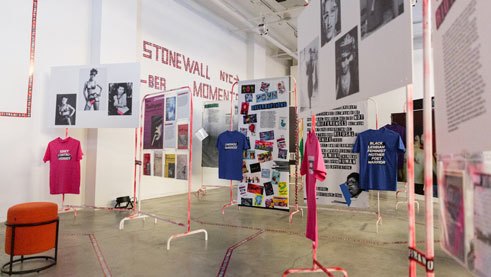Exhibition Opening at the Goethe-Institut New York
Queer as German Folk

The fiftieth anniversary of the Stonewall Uprising is a reason to celebrate, but also to continue fighting for queer rights. The exhibition Queer as German Folk will be on view at the Goethe-Institut New York until 3 August. It’s a space to experience the past and present of the queer movement.
By Jörg Wimalasena
Sometimes it takes a void to direct our gaze to what is missing in the culture of remembrance. In the Queer as German Folk exhibition by curators Birgit Bosold and Carina Klugbauer at the Goethe-Institut in New York there is a big blank space: a photo shows an empty wall next to wreaths. The picture was taken in 1984 in the former Ravensbrück concentration camp. The missing wreath for the lesbian victims of National Socialism symbolises the lack of visibility of homosexual women in queer historiography. “There are people who stay invisible,” said Carina Klugbauer. Women, workers and ethnic minorities receive much less attention in the culture of remembrance than white cis men. The two curators from the Schwules Museum Berlin want to make these people visible in their exhibition.
A labour of love
On the occasion of the fiftieth anniversary of the Stonewall uprising in a New York gay bar, regarded as the beginning of the queer liberation movement in the United States, the Goethe-Institut is attempting to recast the history of the German LGBTIQ+ movement for a transatlantic audience. From the first ambiguously titled magazines for gays and lesbians in the 1950s to current debates on the political influence of the AfD party (Alternative for Germany) on gender discourses, the exhibition leads through the decades-long struggle of sexual minorities for recognition.For the director of the institute, Georg Blochmann, the project is a labour of love. “Decades ago, I belonged to the first generation of gay activists,” explained Georg Blochmann. But as a son of middle-class parents, he had rarely thought about the situation of gay workers or homosexuals with a migrant background or about who remains invisible in the discourse. “I’m all the more proud now that we’re telling the broader story of the queer movement in this exhibition.” While there are hundreds of events around the Stonewall anniversary in New York, “the history of the German queer movement can only be seen here with us.” The director of the Goethe-Institut New York explained, “We wanted to create a space where people can experience the past and present of the movement.”
 Visitors at the exhibition opening in New York
| Photo: Sarah Blesener
Visitors at the exhibition opening in New York
| Photo: Sarah Blesener
Societal challenges
The differences between the emancipatory LGBTIQ+ movements in Germany and the USA are particularly fascinating. “The Stonewall events, for example, weren’t strongly received in Germany until the late 1970s,” noted curator Birgit Bosold. In addition, unlike in the USA, there were no violent police raids on gay bars and, finally, the two countries’ treatment of the “AIDS crisis” was very different. While AIDS assistance organisations were founded in Germany in the 1980s and many regarded the fight against the virus as a mission for society as a whole, in the USA the victims were initially pushed more strongly towards the margins of society.Exhibition on demand
On an exhibition area of almost 80 square metres, the 100 or so objects of Queer as German Folk can be viewed in New York until 3 August. The exhibition will also be shown at the Goethe-Instituts in Montreal, Toronto, Chicago, Washington, San Francisco, Mexico City, the Goethe Centre Guadalajara and the Schwules Museum Berlin (from 18 July).The scenography was developed by the Berlin agency chezweitz, which, among many others, was responsible for the large exhibition Homosexualität_en at the German Historical Museum and the Schwules Museum. As an on-demand exhibition, Queer as German Folk fits on a small thumb drive and will be available to Goethe-Instituts and their partners for the next five years.
 The exhibition is available on demand and will be opened at other exhibition spaces in North America and Europe
| Photo: Sarah Blesener
The exhibition is available on demand and will be opened at other exhibition spaces in North America and Europe
| Photo: Sarah Blesener